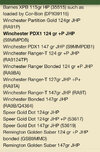For self defense ammunition. Is there really that much difference in standard pressure loadings for the 9mm when you put the 115gr up against the 124gr?
I use 124 HST in Autumn/Winter and 115 Gold Dots for Spring/Summer.
This is out of a Shield and a Hi Power I carry these loads for.
When asking about the difference between 115-grain and 124-grain JHPs, I s'pose that it might be advisable to define the 'difference' that you are concerned with?
If that ''difference' is the terminal performance of JHP ammunition in either weight, the mass of the bullet is just one of three factors that must be considered. Besides bullet mass, impact velocity, and expanded diameter of the bullet must also be considered. At this time, there are no less than five mathematical bullet penetration equations—US Army BRL (Sturdivan, 1973), UTSI (Peters, 1990), WTI (MacPherson, 1995), Q-model (Schwartz, 2012), and the
mTHOR algorithm (Schwartz, 2014)—each model is proven against hundreds of correlative ordnance gelatin data. Using these models allows anyone interested to explore the effect of those three parameters upon terminal performance of any bullet—that is, the maximum penetration depth, volume of the permanent cavity, and the mass of damaged tissues within that volume.
In other words, we can play ''what if'' with these models and get a reasonable estimate of the terminal performance of any bullet that we wish to model.
For example, what if a 9mm 124-grain +P Gold Dot JHP struck a human body at 1,220 fps and expanded to 0.60''? To what depth could we expect it to penetrate and how much tissue (in ounces) would be damaged?
9mm 124-grain +P Gold Dot @ 1,220 fps
mTHOR algorithm (Schwartz, 2014): 12.05 inches and 1.67 ounces
Q-model (Schwartz, 2012): 12.09 inches and 1.68 ounces
WTI (MacPherson, 1995): 12.18 inches and 1.41 ounces
UTSI (Peters, 1990): 12.02 inches and 1.67 ounces
US Army BRL (Sturdivan, 1973): 12.41 inches and 1.72 ounces
Or, we could ask: what if a 9mm 115-grain +P Gold Dot JHP struck a human body at 1,210 fps and expanded to 0.59''? To what depth could we expect it to penetrate and how much tissue (in ounces) would be damaged?
9mm 115-grain +P Gold Dot @ 1,210 fps
mTHOR algorithm (Schwartz, 2014): 11.48 inches and 1.54 ounces
Q-model (Schwartz, 2012): 11.58 inches and 1.55 ounces
WTI (MacPherson, 1995): 11.70 inches and 1.30 ounces
UTSI (Peters, 1990): 11.51 inches and 1.54 ounces
US Army BRL (Sturdivan, 1973): 11.89 inches and 1.60 ounces
Of course, shot placement is important, too—but that's a tactics and training issue which cannot be accounted for by mathematical-physical models like these.


